PLATES OF GOLD
by Daniel Johnson
“And I did teach my people...to work in all manner of...gold, and of silver, and of precious ores, .” (2 Nephi 5:15)
Many people would be surprised to learn that gold disks or plates with carved images and writing have been found in Mesoamerica. Perhaps even more surprising is that archaeologists have known this for a century and yet it is still not common knowledge outside of their discipline. It all began with Edward Herbert Thompson. When he was excavating at Chichén near the turn of the twentieth century, Thompson was enthralled with the sacrificial cenote. Unlike other archaeologists of the time, he believed the Spanish Priest Diego de Landa’s account of offerings and sacrifices at this location. Determined to find them, he began to dredge it in 1904, even donning a diving suit to search the muddy bottom himself.1 When he descended below the water, the locals thought they were seeing the last of him, perhaps believing he was sacrificing himself to the gods of Xibalba. Thankfully, this was not the case and his tireless efforts eventually brought great discoveries to light. What he did not tell Mexican authorities was that for twenty years he had been emptying the cenote of its priceless treasures and sending them all back to the Peabody Museum at Harvard. When this became known in 1926, the Mexican government confiscated his estate at Chichén and he soon returned to the United States.
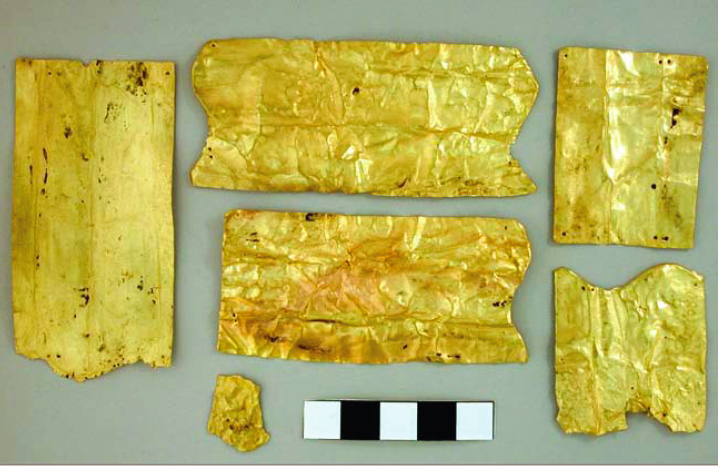
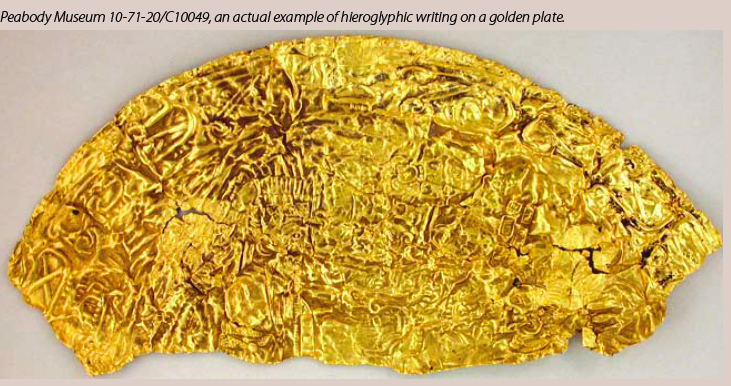
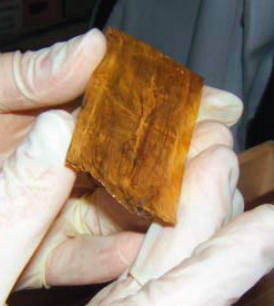
These gold plates are quite remarkable. The detail is astounding, with precise and tiny designs. After inspecting them up close, it is our opinion that very precise and delicate metal tools would be necessary to do such work. The gold itself is very thin, but quite strong and stiff. Most had been crumpled up into balls, either on purpose or by the action of centuries of mud and water, so they have been carefully opened and flattened out as much as possible. Scholars refer to them as disks and believe they are pictured worn or carried by the Toltecs on the murals of the Temple of the Jaguar.
For them, they were important symbols of authority and represented portals into the next world and a means of obtaining revelation and prophecy.5 Other gold objects we saw at the museum are small, rectangular sheets, some flat and some curved. Most of these are plain, but some have designs carved into them. In addition to these small sheets, there are at least 29 of the aforementioned round plates or disks, either whole or in fragments. Some are labeled as gold, but others are described as gold-plated copper or just metal. The curator that showed us these items said that they date to 1910, so they must be what Thompson found during his time at the cenote. In 1961 and 1967, divers found additional gold disks and skeletons,6 but the curator assured us that by that time, artifacts were not removed from Mexico. We know that at least three are on display at the national anthropological museum in Mexico City, so they may have come from these later finds.
 Diane Wirth has suggested that the disk fragment shown at left contains a celestial band, with glyphs for the moon and the center of the sky.7 From what we can tell, no archaeological work is currently being done on these pieces. They are not even out on display for the general public. Drawings were made of them earlier in the twentieth century by Samuel Lothrop, but for the most part, they appear to have been largely forgotten or ignored. We have not seen any photographs of them in books on Mesoamerican artifacts. To see and appreciate them, you may be able to schedule an appointment at the Peabody to be shown them. But we suggest the museum’s excellent website (http://www.peabody.harvard.edu/col/default.cfm), where their entire collection can be searched online using descriptive keywords. The results yield very good photographs of the items, but precious little information about them, other than a vague description and a place of origin.
Diane Wirth has suggested that the disk fragment shown at left contains a celestial band, with glyphs for the moon and the center of the sky.7 From what we can tell, no archaeological work is currently being done on these pieces. They are not even out on display for the general public. Drawings were made of them earlier in the twentieth century by Samuel Lothrop, but for the most part, they appear to have been largely forgotten or ignored. We have not seen any photographs of them in books on Mesoamerican artifacts. To see and appreciate them, you may be able to schedule an appointment at the Peabody to be shown them. But we suggest the museum’s excellent website (http://www.peabody.harvard.edu/col/default.cfm), where their entire collection can be searched online using descriptive keywords. The results yield very good photographs of the items, but precious little information about them, other than a vague description and a place of origin.
One of the few LDS authors to mention these plates recently is Dr. John L. Lund. In Mesoamerica and the Book of Mormon, he shows a simplified drawing of one of them and gives a translation of its carvings.8 However, the particular plate in question has no writing on it and the “translation” is merely a passage from the Popol Vuh. This religious history of the Quiché Maya in the highlands of Guatemala was translated and transcribed by a Spanish priest in the early eighteenth century. There is virtually no connection between this record and gold disks from a distant region like the Yucatán that were crafted almost 900 years earlier. Dr. Lund also claims that Moroni’s use of gold plates to keep records on marks him as a Mesoamerican scribe..9 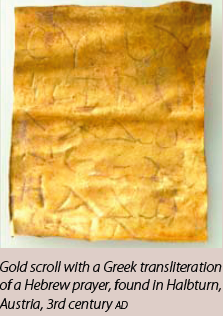 This is an interesting idea, but there is no support for it; only two of the disks from Chichén Itzá in the Peabody’s collection have any glyphs and most of the engravings on them are pictorial. For the most part, these were symbolic items, not written records. The only known writings from Mesoamerica were carved in stone or written on more perishable media like bark paper codices or painted plaster. At times, intriguing but often spurious evidence is used by well-intentioned apologists in support of some of the more controversial aspects of the Book of Mormon. These claims are easily refuted by critics and do not improve our standing in mainstream archaeology. In these areas, solid and sound scholarship is essential.
This is an interesting idea, but there is no support for it; only two of the disks from Chichén Itzá in the Peabody’s collection have any glyphs and most of the engravings on them are pictorial. For the most part, these were symbolic items, not written records. The only known writings from Mesoamerica were carved in stone or written on more perishable media like bark paper codices or painted plaster. At times, intriguing but often spurious evidence is used by well-intentioned apologists in support of some of the more controversial aspects of the Book of Mormon. These claims are easily refuted by critics and do not improve our standing in mainstream archaeology. In these areas, solid and sound scholarship is essential.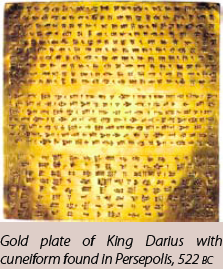 Based on current evidence, the scholarly consensus is that no known Mesoamerican culture like the Olmec, Maya, Zapotec, Aztec, or any other commonly used gold as a medium for writing on. It is certainly not out of the question that metal plates may have been used for sacred or special records by some indigenous peoples; from time to time such stories are circulated among the LDS community. But none are known or accepted as authentic by mainstream archaeologists. Given the Spanish lust for gold during the Conquest, it is unlikely that any such records would have survived to the present day. They would either have been taken and melted down or so well hidden that they were never found. Nephite record keepers’ diligence in protecting the plates had far-reaching effects. Just imagine what the Spanish conquerors would have done had they discovered a cache of golden plates!
Based on current evidence, the scholarly consensus is that no known Mesoamerican culture like the Olmec, Maya, Zapotec, Aztec, or any other commonly used gold as a medium for writing on. It is certainly not out of the question that metal plates may have been used for sacred or special records by some indigenous peoples; from time to time such stories are circulated among the LDS community. But none are known or accepted as authentic by mainstream archaeologists. Given the Spanish lust for gold during the Conquest, it is unlikely that any such records would have survived to the present day. They would either have been taken and melted down or so well hidden that they were never found. Nephite record keepers’ diligence in protecting the plates had far-reaching effects. Just imagine what the Spanish conquerors would have done had they discovered a cache of golden plates!
 It is interesting that the only accepted examples of ancient writing on precious metal plates come from the Old World, mainly from the Middle East. Our suggestion is that this practice originated in that part of the world and was not widely practiced in America outside of Nephite or Jaredite cultures. Any Mesoamerican examples are few and far between, and date to a much later time period. The fact that Nephites kept their most important writings on metal plates indicates a Semitic or Old World scribal tradition. The original Nephi likely got the idea from Laban’s brass plates that he brought from Jerusalem. Keeping records on thin metal plates is apparently not originally an ancient American practice. It is possible that other cultures learned or copied this from Nephites, but it does not appear to have been widely utilized in this hemisphere.
It is interesting that the only accepted examples of ancient writing on precious metal plates come from the Old World, mainly from the Middle East. Our suggestion is that this practice originated in that part of the world and was not widely practiced in America outside of Nephite or Jaredite cultures. Any Mesoamerican examples are few and far between, and date to a much later time period. The fact that Nephites kept their most important writings on metal plates indicates a Semitic or Old World scribal tradition. The original Nephi likely got the idea from Laban’s brass plates that he brought from Jerusalem. Keeping records on thin metal plates is apparently not originally an ancient American practice. It is possible that other cultures learned or copied this from Nephites, but it does not appear to have been widely utilized in this hemisphere.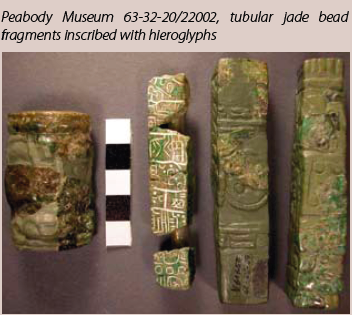
Another issue to consider is that while Jaredites, Nephites, and initially the Lamanites valued precious metals like gold, silver, copper, and their alloys, there is no indication that native peoples held them in the same regard. Among the Maya, jade was considered the most valuable substance during Book of Mormon times, primarily because of its color. Green represented the vital living forces of life, like pools of water and young maize plants.10 Consequently, anything green like jade, quetzal feathers, or the extremely rare green obsidian was of great worth to the Maya and Olmecs.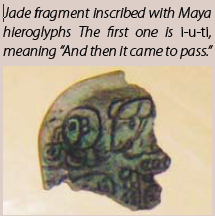 Precious metals did not make much of an impact until much later. The earliest known gold artifact from the Maya area was found in a cache at the foot of Stela H in Copán and dates to ad 730.11 It is obvious that the Nephites kept their metallurgical culture and technology to themselves for much of their history because known Mesoamerican cultures did not have much use or desire for metal at that time period. By contrast, Olmec and Maya jade became objects of trade and were eventually diffused to other areas in Central America. But sometime between ad 400 and 700, gold replaced jade as an item of high value in Costa Rica.12 The feminine color of green was supplanted with the masculine gold, which represented the sun and celestial imagery, but this new interest in gold was not the same as European or Eastern traditions which connected gold with wealth.13 For Native American peoples, the significance of gold was still primarily mystical and symbolic.
Precious metals did not make much of an impact until much later. The earliest known gold artifact from the Maya area was found in a cache at the foot of Stela H in Copán and dates to ad 730.11 It is obvious that the Nephites kept their metallurgical culture and technology to themselves for much of their history because known Mesoamerican cultures did not have much use or desire for metal at that time period. By contrast, Olmec and Maya jade became objects of trade and were eventually diffused to other areas in Central America. But sometime between ad 400 and 700, gold replaced jade as an item of high value in Costa Rica.12 The feminine color of green was supplanted with the masculine gold, which represented the sun and celestial imagery, but this new interest in gold was not the same as European or Eastern traditions which connected gold with wealth.13 For Native American peoples, the significance of gold was still primarily mystical and symbolic.
How did this transition from jade to gold take place? That is not known for sure, but South America has a history of metalworking that extends back to the second millennium bc. The general consensus is that metal goods and eventually the skills to make them originated in the region which now comprises modern-day Peru and Bolivia, then gradually spread northward through trade and other cultural contact. Why did it take so long for metalworking to be adopted in Central and Mesoamerica? That question remains unanswered, but the decline of many Maya centers and the fall of Teotihuacán may have had an impact, cutting off trade routes from north to south.14 This time period is after the destruction of the Nephite civilization, so that cultural void may have had an impact as well. These factors could have been the driving force that opened up trade routes from south to north, allowing for the introduction of metal. If the Nephites did not share their metalworking technology, later Mesoamerican metallurgy owes more to South American influences than to any group mentioned in the Book of Mormon. The archaeological record definitely supports this connection.
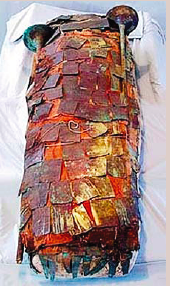 While internal clues in the Book of Mormon support a geographical area like Mesoamerica, the Andean region of South America has a history of metalworking that more closely parallels the time period of the Book of Mormon. Farther away in distance geographically, but closer chronologically are the Moche, a people known for advanced art and metallurgy that flourished in northern Peru 1,000 years before the Inca. In May 2006, a mummy was found in an unlooted Moche tomb, dating to about ad 450. This female was buried with two large metal war clubs and was covered with many thin sheets made of a copper-gold alloy, wrapped up in the cotton burial cloth15 (left). A similar alloy known as tumbaga has been found in later Mesoamerican sites, but this may be the earliest find of the metal, which has been suggested as a likely material for the gold plates. The fact that it has such an early date is also encouraging.
While internal clues in the Book of Mormon support a geographical area like Mesoamerica, the Andean region of South America has a history of metalworking that more closely parallels the time period of the Book of Mormon. Farther away in distance geographically, but closer chronologically are the Moche, a people known for advanced art and metallurgy that flourished in northern Peru 1,000 years before the Inca. In May 2006, a mummy was found in an unlooted Moche tomb, dating to about ad 450. This female was buried with two large metal war clubs and was covered with many thin sheets made of a copper-gold alloy, wrapped up in the cotton burial cloth15 (left). A similar alloy known as tumbaga has been found in later Mesoamerican sites, but this may be the earliest find of the metal, which has been suggested as a likely material for the gold plates. The fact that it has such an early date is also encouraging.
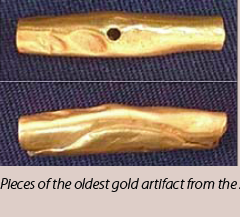 It remains unclear why some South American cultures developed metallurgy so much earlier than those in Central America. This same region has provided the oldest known worked gold artifact in this hemisphere. In March of 2008, the discovery of a nearly 4,000 year old gold necklace was announced. It was found in a Terminal Archaic burial at Jiskairumoko, a site near Lake Titicaca in southern Peru. The necklace was composed of turquoise beads and gold tubes, made from native raw gold pounded flat. Until this discovery, the previously known oldest gold ornament was only 3,400 years old. What is so shocking about this find is that this society was supposed to have been hunter-gatherers, yet someone had the time and skill to make such an unnecessary item. According to one of the archaeologists working at the site, these people were accumulating wealth and using it for personal prestige, something unexpected in a simple society so long ago.16 It seems to indicate a surprising level of social inequality and aggrandizing behavior.17
It remains unclear why some South American cultures developed metallurgy so much earlier than those in Central America. This same region has provided the oldest known worked gold artifact in this hemisphere. In March of 2008, the discovery of a nearly 4,000 year old gold necklace was announced. It was found in a Terminal Archaic burial at Jiskairumoko, a site near Lake Titicaca in southern Peru. The necklace was composed of turquoise beads and gold tubes, made from native raw gold pounded flat. Until this discovery, the previously known oldest gold ornament was only 3,400 years old. What is so shocking about this find is that this society was supposed to have been hunter-gatherers, yet someone had the time and skill to make such an unnecessary item. According to one of the archaeologists working at the site, these people were accumulating wealth and using it for personal prestige, something unexpected in a simple society so long ago.16 It seems to indicate a surprising level of social inequality and aggrandizing behavior.17
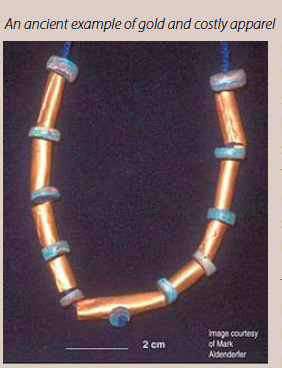 The same kind of behavior can be seen among the Nephites, not long after their arrival in the promised land. Sometime in the latter half of the sixth century bc, Nephi’s brother Jacob chastises his people for doing basically the same thing. In Jacob 2: 12-13, the Nephites had “begun to search for gold, and for silver, and for all manner of precious ores” and “because some of [them] have obtained more abundantly than that of [their] brethren [they] are lifted up in the pride of [their] hearts, and wear stiff necks and high heads because of the costliness of [their] apparel...” Very early in their history, when they should have been more concerned with survival, some Nephites were more interested in displaying their success and lording it over others. This scenario may have seemed unlikely, given all the challenges facing these immigrants to a new land, but we now know that in the Americas other people were doing the same thing 1,500 years earlier. Provocative as these gold objects are, it is obvious that they are not directly related to the Book of Mormon. We must admit that metallurgy does not appear to have been an integral part of Mesoamerican cultures until late in their history, and then perhaps only to a limited extent. The lowlands of the Maya region do not even have the necessary ores; these items had to be brought in from other lands through trade. So we should not look for Nephite cities among late Classic sites like those in the Yucatán Peninsula. We must also assume that Nephites had the ability to smelt ore and create alloys of decorative metals like gold and silver, as well as utilitarian metals like copper and iron, without sharing that technology with their neighbors. This knowledge, as well as the practice of keeping sacred records on metal plates, originated in the Middle East. This scenario is one explanation for the lack of advanced metallurgy among the Olmec or Preclassic Maya. But we need not assume that records kept on metal plates were commonplace among the Nephites or Jaredites, either.
The same kind of behavior can be seen among the Nephites, not long after their arrival in the promised land. Sometime in the latter half of the sixth century bc, Nephi’s brother Jacob chastises his people for doing basically the same thing. In Jacob 2: 12-13, the Nephites had “begun to search for gold, and for silver, and for all manner of precious ores” and “because some of [them] have obtained more abundantly than that of [their] brethren [they] are lifted up in the pride of [their] hearts, and wear stiff necks and high heads because of the costliness of [their] apparel...” Very early in their history, when they should have been more concerned with survival, some Nephites were more interested in displaying their success and lording it over others. This scenario may have seemed unlikely, given all the challenges facing these immigrants to a new land, but we now know that in the Americas other people were doing the same thing 1,500 years earlier. Provocative as these gold objects are, it is obvious that they are not directly related to the Book of Mormon. We must admit that metallurgy does not appear to have been an integral part of Mesoamerican cultures until late in their history, and then perhaps only to a limited extent. The lowlands of the Maya region do not even have the necessary ores; these items had to be brought in from other lands through trade. So we should not look for Nephite cities among late Classic sites like those in the Yucatán Peninsula. We must also assume that Nephites had the ability to smelt ore and create alloys of decorative metals like gold and silver, as well as utilitarian metals like copper and iron, without sharing that technology with their neighbors. This knowledge, as well as the practice of keeping sacred records on metal plates, originated in the Middle East. This scenario is one explanation for the lack of advanced metallurgy among the Olmec or Preclassic Maya. But we need not assume that records kept on metal plates were commonplace among the Nephites or Jaredites, either.
Notes
1 Carolyn Meyer and Charles Gallenkamp, The Mystery of the Ancient Maya (New York, Margaret K.
McElderry Books: 1995), pp. 38-39.
2 Simon Martin and Nikolai Grube, Chronicle of the Maya Kings and Queens (London: Thames & Hudson, 2000), p. 229.
3 Lynn V. Foster, Handbook to Life in the Ancient Maya World (New York: Oxford University Press, 2005), p. 322.
4 Linda Schele and Peter Matthews, The Code of Kings, (New York: Simon & Schuster, 1998), p. 359.
5 Ibid., pp. 222-223.
6 Ibid., pp. 335-336.
7 Personal communication by e-mail, 14 September 2008.
8 See Dr. John L. Lund, Mesoamerica and the Book of Mormon, Is This the Right Place? (The Communications Company, 2007), pp. 83, 92.
9 Ibid., p. 92.
10 Michael J. Snarskis, “From Jade to Gold in Costa Rica:How, Why, and When,” Gold and Power in Ancient Costa Rica, Panama, and Colombia (Washington, D.C.: Dumbarton Oaks Research Library and Collection, 2003),
p. 161.
11 Schele and Mathews, The Code of Kings, p. 348.
12 Snarskis, “From Jade to Gold in Costa Rica:How, Why, and When,” p. 175.
13 Ibid., p. 183.
14 Ibid., p. 193.
15 See A.R. Williams, “Mystery of the Tattooed Mummy,” National Geographic (June 2006), pp. 74, 78-79.
16 12-22-2009. <http://www.msnbc.msn.com/id/23887855/>.
17 12-22-2009. <http://www.pnas.org/content/105/13/5002.full/>.


